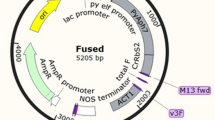Summary
In crassulacean acid metabolism (CAM) large amounts of malic acid are redistributed between vacuole and cytoplasm in the course of night-to-day transitions. The corresponding changes of the cytoplasmic pH (pHcyt) were monitored in mesophyll protoplasts from the CAM plantKalanchoe daigremontiana Hamet et Perrier by ratiometric fluorimetry with the fluorescent dye 2′,7′-bis-(2-carboxyethyl)-5-(and-6-)carboxyfluorescein as a pHcyt indicator. At the beginning of the light phase, pHcyt was slightly alkaline (about 7.5). It dropped during midday by about 0.3 pH units before recovering again in the late-day-to-early-dark phase. In the physiological context the variation in pHcyt may be a component of CAM regulation. Due to its pH sensitivity, phosphoenolpyruvate carboxylase appears as a likely target enzyme. From monitoring ΔpHcyt in response to loading the cytoplasm with the weak acid salt K-acetate a cytoplasmic H+-buffer capacity in the order of 65 mM H+ per pH unit was estimated at a pHcyt of about 7.5. With this value, an acid load of the cytoplasm by about 10 mM malic acid can be estimated as the cause of the observed drop in pHcyt. A diurnal oscillation in pHcyt and a quantitatively similar cytoplasmic malic acid is predicted from an established mathematical model which allows simulation of the CAM dynamics. The similarity of model predictions and experimental data supports the view put forward in this model that a phase transition of the tonoplast is an essential functional element in CAM dynamics.
Similar content being viewed by others
Abbreviations
- CAM:
-
crassulacean acid metabolism
- PEPC:
-
phos-phoenolpyruvate carboxylase
- pHcyt :
-
cytoplasmic pH
- pHo :
-
pH of external medium
References
Blasius B, Beck F, Ltittge U (1997) A model for photosynthetic oscillations in Crassulacean acid metabolism. J Theor Biol 184: 345–351
— Neff R, Beck F, Lüttge U (1999) Oscillatory model of crassulacean acid metabolism with a dynamic hysteresis switch. Proc R Soc Lond B 266: 93–101
Borland AM, Hartwell J, Jenkins GI, Wilkins MB, Nimmo HG (1999) Metabolite control overrides circadian regulation of phos-phoenolpyruvate carboxylase kinase and CO2 fixation in crassulacean acid metabolism. Plant Physiol 121: 889–896
Felle H (1988) Auxin causes oscillations of cytosolic free calcium and pH inZea mays coleoptiles. Planta 174: 495–499
— (1989) pH as a second messenger in plants. In: Boss WF, Morré DJ (eds) Second messengers in plant growth and development. Alan R Liss, New York, pp 145–166
Frohmayer H, Grabov A, Blatt MR (1998) A role for the vacuole in auxin-mediated control of cytosolic pH byVicia mesophyll and guard cells. Plant J 13:109–116
Gehring CA, Irving HR, Parish RW (1994) Gibberellic acid induces cytoplasmic acidification in maize coleoptiles. Planta 194: 532–540
Grabov A, Blatt MR (1997) Parallel control of the inward rectifier K+ channel by cytosolic free Ca2+ and pH inVida guard cells. Planta 201: 84–95
Grynkiewicz G, Poenie M, Tsien RY (1985) A new generation of CO2+ indicators with greatly improved fluorescence properties. J Biol Chem 260: 3440–3450
Irving HR, Gehring CA, Parish RW (1992) Changes in cytosolic pH and calcium of guard cells precede stomatal movement. Proc Natl Acad Sci USA 89:1790–1794
Kluge M, Ting IP (1978) Crassulacean acid metabolism. Springer, Berlin Heidelberg New York (Ecological studies, vol 30)
Lüttge U (1987) Carbon dioxid and water demand: crassulacean acid metabolism (CAM), a versatile ecological adaptation exem-plifying the need for integration in ecophysiological work. New Phytol 106: 593–629
— (2000) The tonoplast functioning as master switch for circadian regulation of crassulacean acid metabolism (CAM). Planta 211: 761–769
— Smith JAC, Marigo G (1982) Membrane transport, osmo-regulation, and the control of CAM. In: Ting IP, Gibbs M (eds) Crassulacean acid metabolism: proceedings of the 5th Annual Symposium on Botany, University of California, Riverside. American Society of Plant Physiologists, Rockville, Md, pp 69–91
— Fischer-Schliebs E, Ratajczak R, Kramer D, Berndt E, Kluge M (1995) Function of the tonoplast in vacuolar C-storage and remobilization in crassulacean acid metabolism. J Exp Bot 46: 1377–1388, special issue
Möllering H (1985) L-(-) Malate. In: Bergmeyer HU (ed) Methods of enzymatic analysis, vol 7, 3rd edn. VCH-Verlagsgesellschaft, Weinheim, pp 39–47
Marigo G, Ball E, Lüttge U, Smith JAC (1982) Use of the DMO technique for the study of relative changes of cytoplasmic pH in leaf cells in relation to CAM. Z Pflanzenphysiol 108: 223–233
Neff R, Blasius B, Beck F, Lüttge U (1998) Thermodynamics and energetics of the tonoplast membrane operating as a hysteresis switch in an oscillatory model of crassulacean acid metabolism. J Membr Biol 165: 37–43
Nimmo HG (2000) The regulation of phosphoenolpyruvate car-boxylase in CAM. Trends Plant Sci 5: 75–80
Nimmo GA, Nimmo HG, Fewson CA, Wilkins MB (1984) Diurnal changes in the properties of phosphoenolpyruvate carboxylase inBryophyllum leaves: a possible covalent modification. FEBS Lett 178:199–203
Osmond CB (1978) Crassulacean acid metabolism: a curiosity in context. Annu Rev Plant Physiol 29: 379–414
Plieth C, Sattelmacher B, Hansen U-P (1997) Cytoplasmic CO2+-H+-exchange buffers in green algae. Protoplasma 198: 107–124
Sanders D, Slayman CL (1982) Control of intracellular pH. J Gen Physiol 80: 377–402
Smith JAC, Lüttge U (1985) Day-night changes in leaf water rela-tions associated with isolated vacuoles of the CAM plantKalan-choe daigremontiana. Planta 162: 299–304
Smith JAC, Uribe EG, Ball E, Lüttge U (1984) ATPase activity associated with isolated vacuoles of the crassulacean acid metabolism plantKalanchoe daigremontiana. Planta 162: 299–304
Steiger S, Pfeifer T, Ratajczak R, Martinoia E, Lüttge U (1997) The vacuolar malate transport ofKalanchoe daigromontiana: a 32 kDa polypeptide? J Plant Physiol 151: 137–141
Thiel G, Blatt MR, Fricker MD, White IR, Miller PA (1993) Modu-lation of K+ channels inVicia stomatal guard cells by peptide homologs to the auxin-binding protein C-terminus. Proc Natl Acad Sci USA 90:11493–11497
Author information
Authors and Affiliations
Rights and permissions
About this article
Cite this article
Hafke, J.B., Neff, R., Hiitt, M.T. et al. Day-to-night variations of cytoplasmic pH in a crassulacean acid metabolism plant. Protoplasma 216, 164–170 (2001). https://doi.org/10.1007/BF02673868
Received:
Accepted:
Issue Date:
DOI: https://doi.org/10.1007/BF02673868




